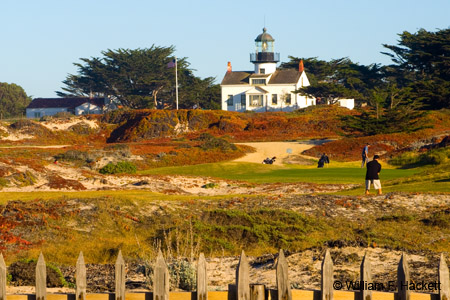Point Piños Light

The Point Piños Light is located in Pacific Grove, CA, and is the oldest continuously-operating lighthouse on the West Coast of the United States. The Point Piños Light has been in operation since February 1, 1855. The Alcatraz Island Lighthouse was in operation 8 months earlier, but was replaced in 1909 during the expansion of the military prison.
The light is a third-order Fresnel lens with lenses, prisms, and mechanism manufactured in France in 1853. Although the original plan had called for a second-order lens, a delay in shipping resulted in the installation of the third-order lens, which had orginally been destined for the Fort Point Light in San Francisco. The actual light source was originally whale oil, forced upward from a tank by a gravity-operated piston. Whale oil was replaced by lard oil, which was replaced by kerosene in 1880. An incandescent vapor light replaced the kerosene at the turn of the century, and this was replaced by an electric light in 1915.
The current light source is a 1000-watt bulb, located 89 feet (27 m) above sea level, light from which, after passing through lenses and prisms, becomes a 50,000 candlepower beam that is visible for up to 15 miles. The signal has a 3 second on, 1 second off signature. A radio beacon and a manually operated foghorn were used up to 1993, but discontinued with the advent of GPS satellite navigation.
Point Piños was named by the Spanish explorer Sebastián Vizcaino in 1602 while exploring the California coastline for the Count of Monterey, the acting Viceroy of New Spain. The name “Punta de los Piños” or “Point of the Pines” refers to the fact that pines grew almost to the edge of the water on the northern tip of the Monterey Peninsula. The diary of the missionary, Father Crespi, refers to a freshwater pond on the point, which is now considered to be Crespi Pond, on the edge of the golf course, just past the lighthouse.
The point was included in 2667 acres (11 km squared) of land granted to José Maria Amenta by the Mexican government in 1833 and re-granted to José Abrego in 1844. After the American acquisition of Alta California, the Secretary of the Treasury ordered seven beacons to be constructed along the California Coast, one of them at Point Piños. The government purchased 25 acres (10.12 hec) of the Rancho Punta de los Piños for the construction and later purchased 67 additional acres (27.11 hec).
The first lightkeeper was Charles Layton, who was killed in 1856 as a member of the posse that chased the outlaw Anastacio Garcia. He was succeeded by his widow Charlotte. Robert Louis Stevenson wrote about visitng the lightkeeper Allen Luce in 1879 and wrote about the lighthouse in the book “From Scotland to Siverado.” The most famous lightkeeper (from 1893 to 1914) was the “Socialite Keeper,” Mrs. Emily Fish, who often entertained guests at the lighthouse.
After I took these photos (1, 2) facing east toward the lighthouse, I took this photo to the north, from the same spot! The photos of the lighthouse are very close to where I took photos (1, 2) of Asilomar State Beach on an earlier trip.
-Bill at Cheshire Cat Photo™
You can view higher-resolution photos (*generally* 7-30 megabytes, compressed) at the Cheshire Cat Photo™ Pro Gallery on Shutterfly™, where you can also order prints and gifts decorated with the photos of your choice from the gallery. Apparel and other gifts decorated with some of our most popular photos can be ordered from the Cheshire Cat Photo™ Store on CafePress®. Both Shutterfly™ and CafePress® ship to most international locations worldwide! If you don’t see what you want or would like to receive an email when new photos are up on the site, send us an email at info@cheshirecatphoto.com.







